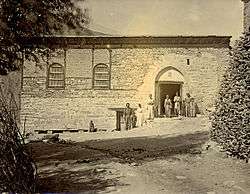Emirate of Hakkâri
The Emirate of Hakkâri (Kurdish: Hekarî) was a Kurdish Sunni Muslim emirate in present-day southeastern Turkey, centered on the city of Hakkâri, and to the west of Lake Urmia on the border with Iran, which ruled a wide variety of peoples.[1]

At the height of its power, the emirate controlled the Turkish provinces of Hakkari and Van, along with some areas in northern Iraq. The population was heterogeneous, with pastoral Kurdish tribes, Nestorian Assyrian Christians who were vassals of the Kurdish tribes, and settled Armenian farmers.[2]
The emirate lasted from the 14th century until 1845, when internal disputes resulted in it briefly coming under the patronage of the last Kurdish Emirate of Botan, led by Muhammed Bedir Khan. Eventually both were absorbed into the Ottoman Empire following the Tanzimat reforms which reorganised and centralised the state.[2]
History
Already established by the 1380s, the founder of the emirate was Izz al-din Shir, a Kurdish noble descended from the Armenian Artsruni dynasty.[3][4] Shir reigned until 1423, having maintained his rule by switching his allegiance variously between the Timurids and the Qara Qoyunlu. Many of his sons and grandsons were later captured or executed by the Qara Qoyunlu Sultan, Qara Iskander.[5][6]
The emirate was re-established by a descendant of Shir named Asad al-din Zarin Cang. Summoned by the Christians of the region from his residence in Egypt, Zarin Cang and his followers stormed and captured his ancestral lands. As this assault occurred on a Saturday (‘’Shambo’’ in the local language), the ruling family was renamed the Shambo dynasty.[7][8] Zarin Cang’s son, Izz al-din Shir II later came into conflict with the Aq Qoyunlu and was killed in 1491 under the orders of its ruler, Sultan Yaqub.[9]
The allegiance of the Hakkâri rulers fluctuated between different overlords in subsequent years. Lying on the border between two powerful warring empires, the Ottomans and the Safavids, the Emirs were able to play the interests of one great power against another by simply switching sides, beginning with Izz al-din Shir II’s son, Zahid Beg. The following period was turbulent, with much inter-familial conflict in the ruling family. Different members sided with different empires and rebellions were launched by Shambo princes against their fathers. Thirteen different emirs were crowned within the space of a century.[10] After the Ottoman-Safavid wars, the Hakkari no longer had the ability to manoeuvre their Ottoman overlords to their advantage and began to lose power and status.[11]
In the 1820s, the Emirate of Hakkâri was consumed by a conflict between Nur Allah Beg and Suleiman Beg.[12] Nestorian Assyrian tribes took sides, with the patriarch Mar Shinum throwing his support behind Suleiman Beg. The influence of Western missionaries and their associated governments also unbalanced the religious equilibrium between Christian and Muslim tribes at a time when the Ottoman state was weakened by wars with Russia in 1828-29 and Egyptian ruler Muhammed Ali in 1831.[13]

Emir Nur Allah Beg of Hakkâri and Muhammed Bedir Khan massacred the Nestorian Assyrians within their lands in 1843 following the encouragement of the Ottoman authorities, who associated them with the growing influence of Western missionaries and of Britain and Russia. Subsequently, the Ottomans attempted to exert their authority over the Kurdish statelets, resulting in a confrontation between the Ottoman military and the Bedir Khan Kurdish coalition in 1847. The Kurdish tribes were defeated, and Bedir Khan sent into exile.[2]
References
- Bengio, Ofra (2014-11-15). Kurdish Awakening: Nation Building in a Fragmented Homeland. University of Texas Press. ISBN 9780292758131.
- Eppel, Michael (2016-09-13). A People Without a State: The Kurds from the Rise of Islam to the Dawn of Nationalism. University of Texas Press. ISBN 9781477311073.
- Alexander Khachatrian, The Kurdish Principality of Hakkariya (14th-15th Centuries), Iran & the Caucasus, Vol. 7, No. 1/2 (2003), p. 57
- Avedis K. Sanjian, Journal of the Society for Armenian Studies, Volumes 1-2 (1984), p. 132-3
- Khachatrian (2003, p. 47, 49-50)
- S. Album, A Hoard of Silver Coins from the Time of Iskandar Qarā-Qoyūnlū, The Numismatic Chronicle Vol. 16 (1976), p. 119
- M.Th. Houtsma, A.J. Wensinck, T.W. Arnold, W. Heffening, E. Levi-Provencal, E.J Brill’s First Encyclopaedia of Islam 1913-1936, Vol. IV (1993), p. 1146
- Khachatrian (2003, p. 51-2)
- Khachatrian (2003, p. 54-6)
- Lale Yalçın-Heckmann, Tribe and kinship among the Kurds (1991), p. 50
- Eppel (2016, p. 48)
- nzibari (2012-04-16). "The downfall of Bedrkhan and the end of Botan". Kurdish Musings. Retrieved 2017-06-28.
- Bengio, Ofra (2014-11-15). Kurdish Awakening: Nation Building in a Fragmented Homeland. University of Texas Press. ISBN 9780292758131.